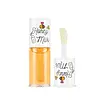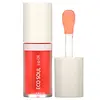What's inside
What's inside
 Key Ingredients
Key Ingredients

 Benefits
Benefits

 Concerns
Concerns

 Ingredients Side-by-side
Ingredients Side-by-side

Polybutene
Diisostearyl Malate
EmollientHydrogenated Polyisobutene
EmollientTridecyl Trimellitate
EmollientSilica Silylate
EmollientSilica Dimethyl Silylate
EmollientParfum
MaskingDehydroacetic Acid
PreservativePolyglyceryl-2 Triisostearate
EmulsifyingCI 19140
Cosmetic ColorantCI 15985
Cosmetic ColorantTocopheryl Acetate
AntioxidantMilk Protein Extract
Honey Extract
Humectant1,2-Hexanediol
Skin ConditioningPhenoxyethanol
PreservativeEthylhexylglycerin
Skin ConditioningPolybutene, Diisostearyl Malate, Hydrogenated Polyisobutene, Tridecyl Trimellitate, Silica Silylate, Silica Dimethyl Silylate, Parfum, Dehydroacetic Acid, Polyglyceryl-2 Triisostearate, CI 19140, CI 15985, Tocopheryl Acetate, Milk Protein Extract, Honey Extract, 1,2-Hexanediol, Phenoxyethanol, Ethylhexylglycerin
Polyglyceryl-2 Isostearate/Dimer Dilinoleate Copolymer
EmollientHelianthus Annuus Seed Oil
EmollientSimmondsia Chinensis Seed Oil
EmollientTocopheryl Acetate
AntioxidantOlea Europaea Fruit Oil
MaskingSilica Dimethyl Silylate
EmollientCamellia Japonica Seed Oil
EmollientPolyhydroxystearic Acid
EmulsifyingCamellia Sinensis Seed Oil
HumectantArgania Spinosa Kernel Oil
EmollientMacadamia Integrifolia Seed Oil
Skin ConditioningCeramide NP
Skin ConditioningParfum
MaskingRosa Damascena Flower Water
MaskingLecithin
EmollientIsostearic Acid
CleansingIsopropyl Myristate
EmollientEthylhexyl Palmitate
EmollientDiisostearyl Malate
EmollientDehydroacetic Acid
PreservativePolyglyceryl-3 Polyricinoleate
EmulsifyingMonascus Extract
Skin ConditioningWater
Skin ConditioningButylene Glycol
HumectantMentha Viridis Leaf Oil
AstringentCI 15850
Cosmetic ColorantEclipta Prostrata Extract
Skin ConditioningCI 15985
Cosmetic Colorant1,2-Hexanediol
Skin ConditioningMelia Azadirachta Leaf Extract
Skin ConditioningMoringa Oleifera Seed Oil
EmollientRubus Idaeus Fruit Extract
AstringentVaccinium Angustifolium Fruit Extract
Skin ProtectingMorus Alba Root Extract
BleachingFragaria Vesca Fruit Extract
AstringentOriganum Vulgare Leaf Extract
Skin ConditioningChamaecyparis Obtusa Leaf Extract
Skin ConditioningSalix Alba Bark Extract
AstringentLactobacillus/Soybean Ferment Extract
Skin ConditioningPortulaca Oleracea Extract
Skin ConditioningCinnamomum Cassia Bark Extract
MaskingScutellaria Baicalensis Root Extract
AstringentPolyglyceryl-2 Isostearate/Dimer Dilinoleate Copolymer, Helianthus Annuus Seed Oil, Simmondsia Chinensis Seed Oil, Tocopheryl Acetate, Olea Europaea Fruit Oil, Silica Dimethyl Silylate, Camellia Japonica Seed Oil, Polyhydroxystearic Acid, Camellia Sinensis Seed Oil, Argania Spinosa Kernel Oil, Macadamia Integrifolia Seed Oil, Ceramide NP, Parfum, Rosa Damascena Flower Water, Lecithin, Isostearic Acid, Isopropyl Myristate, Ethylhexyl Palmitate, Diisostearyl Malate, Dehydroacetic Acid, Polyglyceryl-3 Polyricinoleate, Monascus Extract, Water, Butylene Glycol, Mentha Viridis Leaf Oil, CI 15850, Eclipta Prostrata Extract, CI 15985, 1,2-Hexanediol, Melia Azadirachta Leaf Extract, Moringa Oleifera Seed Oil, Rubus Idaeus Fruit Extract, Vaccinium Angustifolium Fruit Extract, Morus Alba Root Extract, Fragaria Vesca Fruit Extract, Origanum Vulgare Leaf Extract, Chamaecyparis Obtusa Leaf Extract, Salix Alba Bark Extract, Lactobacillus/Soybean Ferment Extract, Portulaca Oleracea Extract, Cinnamomum Cassia Bark Extract, Scutellaria Baicalensis Root Extract
 Reviews
Reviews

Alternatives
Ingredients Explained
These ingredients are found in both products.
Ingredients higher up in an ingredient list are typically present in a larger amount.
1,2-Hexanediol is a synthetic liquid and another multi-functional powerhouse.
It is a:
- Humectant, drawing moisture into the skin
- Emollient, helping to soften skin
- Solvent, dispersing and stabilizing formulas
- Preservative booster, enhancing the antimicrobial activity of other preservatives
Ci 15985 is a dye made from petroleum. It is synthetically created and approved by the FDA for use in foods and cosmetics.
The color of this dye is orange/yellow.
This ingredient can be found in makeup, sun care, and skincare.
Learn more about CI 15985Dehydroacetic Acid is fungicide and bactericide. It is used as a preservative in cosmetics. Preservatives help elongate the shelf life of a product.
Dehydroacetic Acid is not soluble in water.
Diisostearyl Malate is an emollient and most often used in lip products. It comes from isostearyl alcohol, a fatty acid, and malic acid, an AHA.
As an emollient, Diisostearyl Malate helps create a thin film on your skin to trap moisture in. This helps keep your skin soft and smooth.
Parfum is a catch-all term for an ingredient or more that is used to give a scent to products.
Also called "fragrance", this ingredient can be a blend of hundreds of chemicals or plant oils. This means every product with "fragrance" or "parfum" in the ingredients list is a different mixture.
For instance, Habanolide is a proprietary trade name for a specific aroma chemical. When used as a fragrance ingredient in cosmetics, most aroma chemicals fall under the broad labeling category of “FRAGRANCE” or “PARFUM” according to EU and US regulations.
The term 'parfum' or 'fragrance' is not regulated in many countries. In many cases, it is up to the brand to define this term.
For instance, many brands choose to label themselves as "fragrance-free" because they are not using synthetic fragrances. However, their products may still contain ingredients such as essential oils that are considered a fragrance by INCI standards.
One example is Calendula flower extract. Calendula is an essential oil that still imparts a scent or 'fragrance'.
Depending on the blend, the ingredients in the mixture can cause allergies and sensitivities on the skin. Some ingredients that are known EU allergens include linalool and citronellol.
Parfum can also be used to mask or cover an unpleasant scent.
The bottom line is: not all fragrances/parfum/ingredients are created equally. If you are worried about fragrances, we recommend taking a closer look at an ingredient. And of course, we always recommend speaking with a professional.
Learn more about ParfumThis silica is mainly used to thicken oils and suspend particles in oils. It is not water soluble.
According to the manufacturer, it:
The manufacturer also claims this ingredient to be useful in makeup.
In lipstick formulations, this ingredient improves color payoff, reduces pigment settling, and reduces oil bleeding. This ingredient also improves the grip of powder products such as dry shampoos.
Learn more about Silica Dimethyl SilylateTocopheryl Acetate is AKA Vitamin E. It is an antioxidant and protects your skin from free radicals. Free radicals damage the skin by breaking down collagen.
One study found using Tocopheryl Acetate with Vitamin C decreased the number of sunburned cells.
Tocopheryl Acetate is commonly found in both skincare and dietary supplements.
Learn more about Tocopheryl Acetate